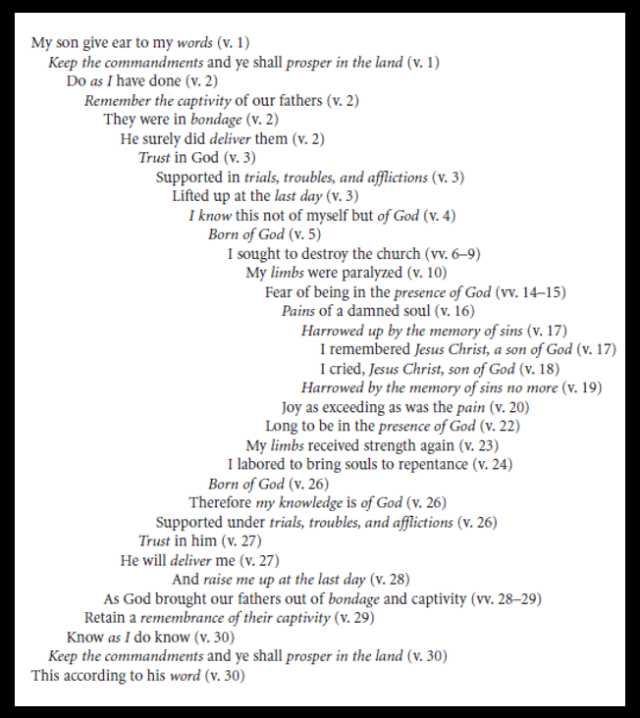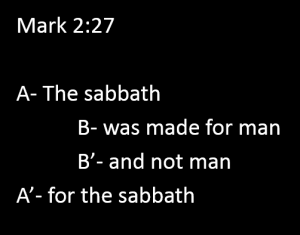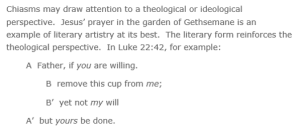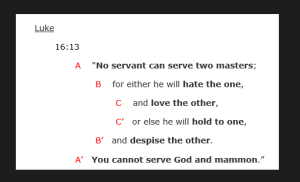Alma 36 is a wonderful example of chiasmus. What is chiasmus, you ask?
chi·as·mus – kīˈazməs/
noun: chiasmus; plural noun: chiasmi
1. a rhetorical or literary figure in which words, grammatical constructions, or concepts are repeated in reverse order, in the same or a modified form; e.g. ‘Poetry is the record of the best and happiest moments of the happiest and best minds.’
Alma used chiasmus to tell the story of his conversion to his son Helaman. The presence of Semitic literary forms such as chiasmus in the Book of Mormon is an external witness that the book is what the Prophet Joseph Smith taught that it is: a translation of an ancient text written in a Middle Eastern language. The fact that this structure exists throughout the text of the Book of Mormon should cause any thoughtful investigator of the book to pause and take this text seriously. While it is my opinion chiasmus does not prove the Book of Mormon to be true (only the witness of the Holy Ghost will do this), it is one more evidence of its divine and ancient origins that will help to foster a climate where belief may flourish.
Authors of a multitude of ancient works, including the Bible and the Book of Mormon used chiasmus. 1 These ancient works that contain chiasmus are as widespread as Sumero-Akkadian literature, Ugaritic writings, Aramaic contracts and letters, Talmudic-Aggadic narratives, and many classic works of ancient Greek and Latin works. 2
Richard Grant, sharing a thought from a college course on chiasmus, explains why:
“Why Chiasmus? In the very long time before we started to write things down in lap-top computers, people had to rely on their memories. Think of throwing stuff in a box. If you just toss it in, it is jumbled, not compact, and things get broken. If you pack the box, however, you can make sure that all available space is used safely and well: that objects fit together; the ones you need often are on top, and that nothing gets lost.
Just so with memory. It needs a little help to get along, and early peoples used ‘mnemonic devices,’ usually involving an imagined space into which they put things to be remembered. . . Here’s where chiasmus came in.
Chiasmus was a kind of formula that allowed each normal object to be mirrored in a double. The double was ‘stored’ in a disguised form, present but concealed. As the sequence progressed, the double relationship intensified . . . , and in subsequent scenes the meaning of the doubled elements was revealed.” 3
Examples of Chiastic Structures in the Bible
Alma 36 is a Beautiful Chiasmus
Alma 36 is a wonderful example of this type of literature. As I have studied this chapter, I would say that everything that Alma is teaching us points us to the apex, or center of this work: that through Jesus Christ, Alma was able to be freed from the captivity of sin and guilt. He is illustrating how we can be saved, using his experience to do so.
 A pdf of this illustration of the text can be found here.
A pdf of this illustration of the text can be found here.
John Welch sums up the evidence:
 For those who are inclined to think about such matters in terms of statistical probabilities, the multiple findings discussed may be summarized in the form of a series of predictions: for instance, what is the likelihood of chiasms not only accidentally occurring, but also intensifying the orderly character of the text, increasing the intricate depth of the text, significantly enhancing its artistic achievement, precisely fitting natural textual units, systematically clarifying meaning and providing demonstrable keys to textual interpretation, maintaining stylistic consistency within the writings of individual authors, emerging as reworkings of earlier texts, corresponding with other dimensions of authorial intent, appearing principally in quoted original texts as opposed to abridged materials, and working even better in Hebrew than English? The probability that all these and other similar predictions would simultaneously occur becomes remotely small, lending considerable cumulative weight that corroborates the explanation of the book’s origins declared by Joseph Smith and claimed by the book itself. 4
For those who are inclined to think about such matters in terms of statistical probabilities, the multiple findings discussed may be summarized in the form of a series of predictions: for instance, what is the likelihood of chiasms not only accidentally occurring, but also intensifying the orderly character of the text, increasing the intricate depth of the text, significantly enhancing its artistic achievement, precisely fitting natural textual units, systematically clarifying meaning and providing demonstrable keys to textual interpretation, maintaining stylistic consistency within the writings of individual authors, emerging as reworkings of earlier texts, corresponding with other dimensions of authorial intent, appearing principally in quoted original texts as opposed to abridged materials, and working even better in Hebrew than English? The probability that all these and other similar predictions would simultaneously occur becomes remotely small, lending considerable cumulative weight that corroborates the explanation of the book’s origins declared by Joseph Smith and claimed by the book itself. 4
Notes
1. John W. Welch, Book of Mormon Authorship: New Light on Ancient Origins, chapter 2: Chiasmus in the Book of Mormon. See also: John Breck, The Shape of Biblical Language: Chiasmus in the Scriptures and Beyond Edition 2, St Vladimirs Seminary, 2008. Jeff A. Benner, Hebrew Parallelism (Chiasmus).
2. David Noel Freedman, “Preface,” in John Breck, The Shape of Biblical Language (Crestwood, NY: St. Vladimir’s Seminary Press, 1994), 7. See also: Brad McCoy, Chiasmus: An Important Structural Device Commonly Found in Biblical Literature, Isaac Kalimi, The Reshaping of Ancient Israelite History in Chronicles, p. 215.
3. Richard Grant, Chiasmus in the Book of Mormon: A Remarkable Literary Art
4. John W. Welch, “What Does Chiasmus in the Book of Mormon Prove?” Book of Mormon Authorship Revisited , F.A.R.M.S., pp. 200-224, emphasis added.





No Comments
Comments are closed.